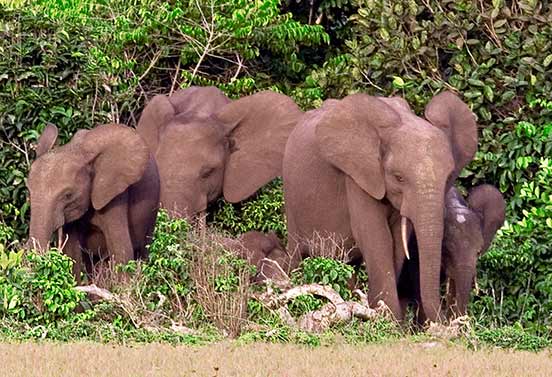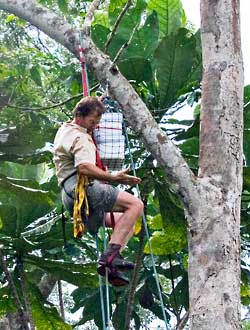Hidden Costs of Energy Exploration on Africa’s Forest Elephants
By Laura Erickson; Photographs by Peter Wrege
October 15, 2009
Bioacoustic Research Program’s Elephant Listening Project searches for sound solutions
According to the U.S. Department of Energy, every day in June 2009, the United States imported 9.172 million barrels of crude oil, most of it from Canada, Venezuela, Mexico, Saudi Arabia, and Nigeria; imports amount to 65 percent of America’s oil usage. The remaining 35 percent of the total oil used by Americans comes from domestic supplies. We often think of the non-dollar costs of our enormous oil usage in terms of spills, air pollution, and carbon emissions and climate change, but there are other costs that are even harder to assess—costs paid for both by human beings and by wildlife with no voice to protest.
Peter Wrege, director of the Elephant Listening Project in the Bioacoustics Research Program at the Cornell Lab of Ornithology, has been researching African forest elephants before, during, and after oil and gas exploration in central Africa, to see what effects these projects have on this dangerously declining population. His team found that forest elephants don’t seem to be disturbed by seismic jolts during exploration. When Peter examined the spectrographs of these blasts, he learned that blasting sounds very much like thunder, a common sound in the elephants’ rainy forest habitat. But Peter’s research did uncover a more cryptic but important effect of disturbance: elephants made a dramatic shift in behavior, conducting 20 percent more of their activities at night than in the day. How this is affecting the animals’ survival and behaviors is still being studied.

These African elephants are genetically distinct from the larger African savannah elephants and have five toenails on the front foot and four on the hind foot. (African savanna elephants normally have four toenails on the front foot and three on the hind foot.) Many authorities now consider African forest elephants to be a separate species.
How exactly does energy exploration harm them? According to a 2003 paper in Conservation Biology, oil exploration has much greater personnel requirements than logging operations do, and the associated roads and new settlements created in what had been pristine habitat pose significant problems for wildlife. The settlements also greatly increase the demand for “bushmeat,” and although harvesting primates, elephants, and many other species is tightly regulated, enforcement can be dangerously lax.

In open savannas where the larger African elephants live, poaching can easily be monitored from airplanes, and carcasses are quickly discovered. So enforcement is better in eastern and southern Africa than it is in central Africa, where there are huge continuous forests, only a little of which is protected as national parks. Ironically, illegal poaching is minimal during the time oil exploration is going on, when industry personnel monitor activities. It’s after the oil companies leave that poaching begins, and the new roads give poachers easy access.
Peter believes that as long as conservation laws allow us to keep pressure on energy companies, they will work to minimize the impact of exploration and extraction on protected species. He’s learned that sometimes reasonable compromises can be forged to protect the needs of wildlife. For example, research shows that chainsaws used to cut transects for seismic exploration cause enormous disruption for primates and elephants. Cutting transects without chainsaws takes more time and costs more money, but factoring the costs to wildlife may justify restrictions in reserves and national parks. Requiring oil companies to close off access to roads to all but legitimate use can also help. In autumn 2009, a logging company in Gabon will use an acoustic recorder to provide a record of all road activity, to eliminate the possibility of poachers bribing entrance guards to enter.
Peter’s work focuses on elephants, but his commitment is to forest conservation. “The elephant is an icon for the central forest habitat, which also contains lowland gorillas, chimpanzees, and tons of birds,” he said. By ensuring protections for African forest elephants, Peter’s research team is providing hope for an entire community of wildlife.
Originally published in the October 2009 issue of BirdScope.

All About Birds
is a free resource
Available for everyone,
funded by donors like you
American Kestrel by Blair Dudeck / Macaulay Library
